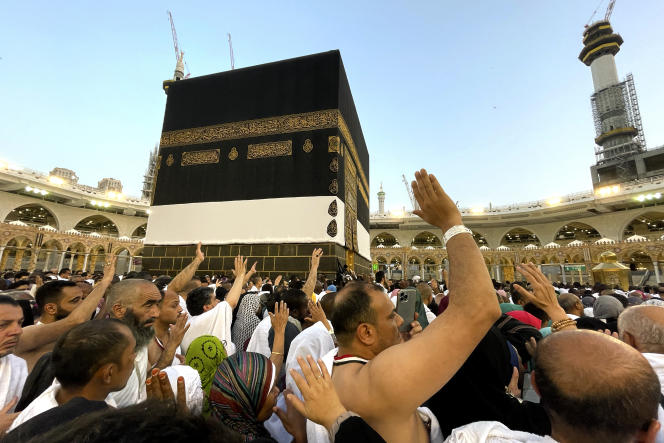Under overwhelming heat, the hajj began on Sunday June 25 in Mecca with hundreds of thousands of Muslims, the first pilgrimage with as many faithful in the Saudi kingdom as in the years preceding the Covid-19 pandemic.
More than two million pilgrims from 160 countries are expected in Islam’s holiest city in western Saudi Arabia this year, after three years of limiting the number of participants due to the health crisis.
At the heart of Mecca’s Grand Mosque, worshipers began performing the tawaafor the processions around the Kaaba, a large cubic structure draped in black cloth embroidered with gold, to which Muslims around the world turn for prayer.
One of the five pillars of Islam, the hajj must be performed at least once in the life of a practicing Muslim who can afford it. It consists of a series of religious rites performed over several days in the holy city and its surroundings.
Pilgrims will travel to Mina, about 5 kilometers from the Grand Mosque, on Sunday evening before the main rite at Mount Arafat, where the Prophet Muhammad is said to have delivered his last sermon.
Heat and high cost
Hosting the two major Muslim pilgrimages, the hajj and the umrah (minor pilgrimage), lends prestige and legitimacy to Saudi rulers. Many tragedies, including deadly stampedes, have marked the history of the hajj, but no major accident has been recorded since 2015.
With high temperatures – approaching 45 degrees Celsius – in one of the world’s hottest regions posing a growing challenge, authorities have set up numerous health centers and deployed 32,000 paramedics. Patrolling on foot, under white umbrellas to protect themselves from the sun, police doused the pilgrims with water. Inside the Grand Mosque, thousands of rescuers are ready to intervene.
The hajj, which costs at least $5,000 per person, is an important source of income for the world’s biggest oil exporter, which is trying to diversify its economy. Before the Covid-19 pandemic, it brought in several billion dollars a year. The authorities hope this year to approach the threshold of 2.5 million pilgrims reached in 2019, after welcoming 926,000 visitors in 2022. In 2020 and 2021, at the height of the health crisis, only a few thousand people had been admitted .
It is also an opportunity for the Saudi authorities to show signs of openness in the ultra-conservative kingdom, in the face of numerous accusations of human rights violations. Thus, since 2021, Saudi Arabia has allowed women to make the pilgrimage without being accompanied by a male guardian. At the same time, in August 2022, the Saudi justice sentenced the young doctoral student in medicine Salma Al-Chehab to thirty-four years in prison for having shared messages in favor of women’s rights.
